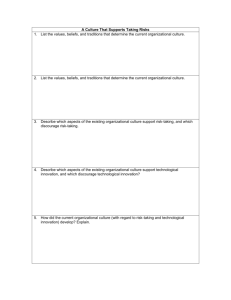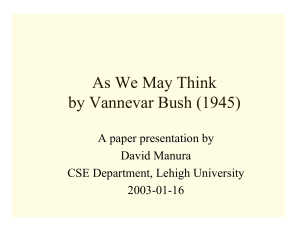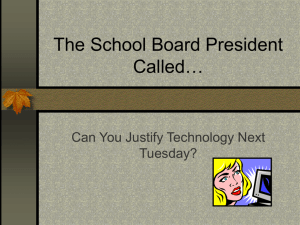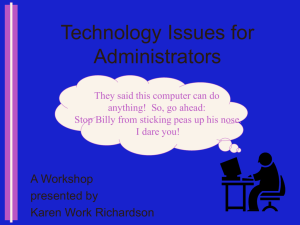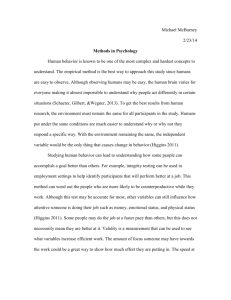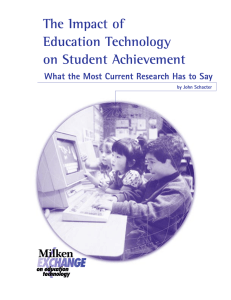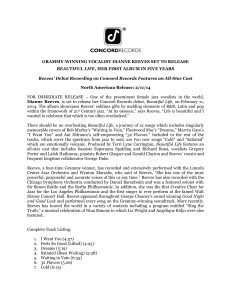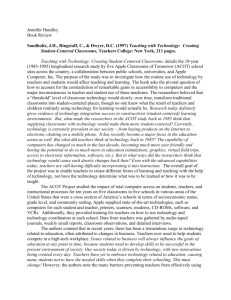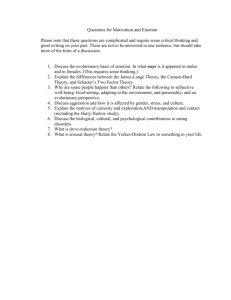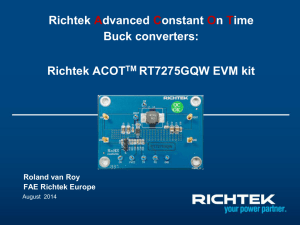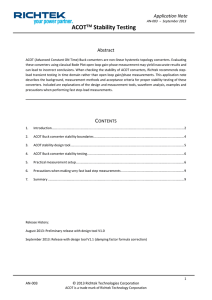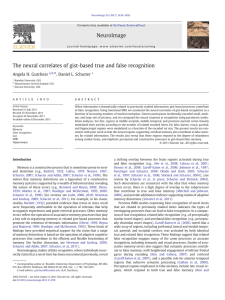PowerPoint-2
advertisement
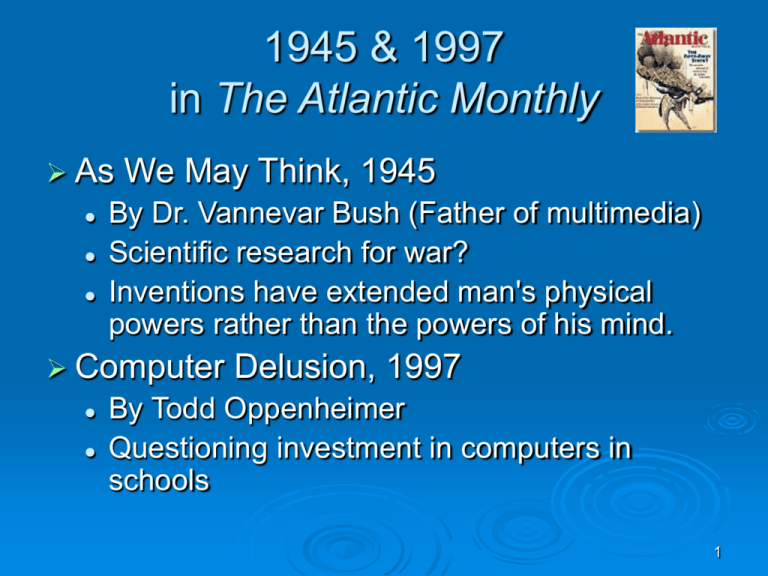
1945 & 1997 in The Atlantic Monthly As We May Think, 1945 By Dr. Vannevar Bush (Father of multimedia) Scientific research for war? Inventions have extended man's physical powers rather than the powers of his mind. Computer Delusion, 1997 By Todd Oppenheimer Questioning investment in computers in schools 1 Father of Multimedia Dr. Vannevar Bush As We May Think, The Atlantic Monthly, 1945 “Consider a future device for individual use, which is a sort of mechanized private file and library. It needs a name, and to coin one at random, ``memex'' will do. A memex is a device in which an individual stores all his books, records, and communications, and which is mechanized so that it may be consulted with exceeding speed and flexibility. It is an enlarged intimate supplement to his memory. It consists of a desk, and while it can presumably be operated from a distance, it is primarily the piece of furniture at which he works. On the top are slanting translucent screens, on which material can be projected for convenient reading. There is a keyboard, and sets of buttons and levers. Otherwise it looks like an ordinary desk.” 2 Computer Delusion Todd Opennheimer The Atlantic Monthly, 1997 “There is no good evidence that most uses of computers significantly improve teaching and learning, yet school districts are cutting programs --- music, art, physical education --- that enrich children’s lives to make room for this dubious nostrum…” 3 What were the visions? 先來想像一下、、、 02:10 Classroom as theater (Slides,16mm) Teaching machine (TV) Interactive and Fun (Multimedia) Individualized with no boundary (Hypermedia) … Canon 電子紙 4 Classroom as Theatre Thomas Edison, 1922 “… the motion picture is destined to revolutionize our education system and … in a few years it will supplant largely, if not entirely, the use of textbooks.” 5 Teaching Machine Sydney Pressey, 1926 “… teaching machines are unique among instructional aids, in that the student not merely passively listen, watches, or reads but actively responds. And as he does so he finds out whether his response is correct or not. And a record may be kept which aids in improving the materials.” 6 Television as Teaching Machine Edward R. Murrow, 1958 “This instrument can teach, it can illuminate; yes, it can even inspire. But it can do so only to the extent that humans are determined to use it to those ends. Otherwise, it is merely lights and wires in a box..” When two vowels go walking. 01:30 7 Teaching Machine B. F. Skinner, 1961 “A frame of textual material appearing in the square opening is incomplete: in place of certain letters or figures there are holes. Letters or figures can be made to appear in these holes by moving slides... When the material has been completed, the student checks his response… if they are correct, moves a new frame of material into place…“ “… with the help of teaching machines and programmed instruction, students could learn twice as much in the same time and with same effort as in a standard classroom.“ 8 Seymour Papert The Gears of My Childhood, 1980 “What an individual can lean, and how he learns it, depends on what models he has available… … The computer is the Proteus of machines. Its essence is its universality, its power to stimulate. Because it can take on a thousand forms and can serve a thousand functions, it can appeal to a thousand tastes.” 9 School’s Out Lewis Perelman, 1992 “Because the pervasive and potent impact of HL (hyper-learning) technology, we now are experiencing the turbulent advent of an economic and social transformation more profound than the industrial revolution… In the wake of the HL revolution, the technology called ‘school’ and the social institution commonly thought of as ‘education’ will be as obsolete and ultimately extinct as the dinosaurs.” 10 高互動教室 中央大學, 2000 「按按按」的硬體設計採用師生慣用的紅外線遙控裝置,經由與後端教 材題庫的結合,教師可輕易運用於教學活動中,所有學生學習歷程的資料都 會在學生每按一次遙控器按鍵後,傳回後端的學習資料庫中,配合恰當的資 料統計與分析過程,老師及家長可精確了解到學生的學習情況。 01:05 Compare with teaching machine (Pressey, 1926) 11 No Significant Difference Compiled by Thomas L. Russell, 1999 Foreword by Richard E. Clark 355 research reports, summaries and papers Technology and Distance/Self learning 12 Richard E. Clark Media Will Never Influence Learning, 1983; 1994 “The best current evidence is that media are mere vehicles that deliver instruction but do not influence student achievement any more than the truck that delivers our groceries causes changes in our nutrition.” “… the choice of vehicle might influence the cost or extent of distributing instruction.” “… it was not the medium which influenced learning but instead certain attributes of media that can be modeled by learners and can shape the development of unique ‘cognitive process’.” 13 台灣的發展 淡江大學 大一英文CAI 1986 台北西松國中 英文CAI實驗教學 1990 TANET 1998 擴大內需方案 2000 亞卓市EduCities 2002 eLearning … 1976 14 科技決定論? Technological Determinism Is this the model you envision? 06:30 Alternative perspectives? Hard Sphere vs. Soft Sphere Hot Media vs. Cold Media 15 非關教育,很久以前的願景… Scientific American, 1889 “… the improvement in city condition by general adoption of the motor car can hardly overestimated. Street clean, dustless, and odorless, with light rubber-tired vehicles moving swiftly and noiselessly over smooth expanse, would eliminate a great part of the nervousness, distraction, and strain of modern metropolitan life.” 16 Started with A Question What happens to students and teachers when they have access to technology whenever they need it? 1995, The Apple Classroom of Tomorrow (ACOT) Project 17 What Research Has to Say? John Cradler (1996) 1990-1994 Summary Thomas Learning “from” and “with” technology John C. Reeves (1998) Schacter (1999) Analysis of 5 large studies (meta-analysis), additionally 2 smaller studies using newer technologies 18 John Cradler, 1996 Student Outcomes Educator outcomes Effectiveness of technology tends vary as a function of curriculum content and instructional strategy delivered by technology Benefits of technology for teaching is generally positive with a shift from the more traditional directive to a more student-centered approach Development factors Particular features of technology-based resources are critical for effective application; e.g., instant feedback, correctness of responses, individualized problem solving, built-in assessment 19 Thomas C. Reeves, 1998 Learning “from” media and technology Television No conclusive evidence, TV stultifies mind TV viewing not displaces academic activities Positive effectiveness Instructional TV, especially while production aided by real teachers No difference between live teacher and video presentation 20 Thomas C. Reeves, 1998 Learning “from” media and technology Computer-based Instruction Positive effectiveness in general as tutor: Motivation and Standardized achievement test Less time to complete a given lesson No significant impact of intelligent tutoring due to technical difficulties 21 Thomas C. Reeves, 1998 Learning “with” media and technology Great effectiveness within constructivist learning environment Representing knowledge support deep reflective thinking Mindfulness and engagement Learning to learn, and wishing to innovate 22 John Schacter, 1999 Positive Findings: (Kulik ,1994) Students who use computer-based instruction scored at the 64th percentile on tests of achievement, students in the control conditions scored at the 50th. Students learn more in less time using CAI. More positive attitudes. Negative Findings: (Kulik ,1994) Computers did not have positive effects in every study areas. 23 John Schacter, 1999 Positive Findings: (Sivin-Kachala ,1998) Students in technology rich environments experienced positive effects on achievement in all major subject areas. Students in technology rich environments showed increased achievement in preschool through higher education for both regular and special needs children. Students’ attitudes toward learning and self-concept improved. Inconclusive Findings: (Sivin-Kachala ,1998) Levels of effectiveness of educational technology is influenced by specific student population, software design, educators’ role, and levels of access to technology. 24 John Schacter, 1999 Positive Findings: (ACOT ,1994) The ACOT experience appeared to result in new learning experience requiring higher level reasoning and problem solving (not conclusive) Positive impact on students’ attitudes, and changing teaching practices; more cooperative group and less stand-up lecturing. Negative Findings: (ACOT ,1994) ACOT students performed no better than comparison group or national norms on standardized tests (vocabulary, math concepts, reading…) 25 Emperor’s New Clothes? Jamie McKenzie, 1995 Too often, lower order task and basic skills examined Too little work on measuring gains in higher order skills Biased research; flawed methodology Little evidence that growth in skills persists beyond initial “gadget stage” 26 Lack of Actual Evaluation Report Jamie McKenzie, 1995 1980 – 8 1981 – 16 1982 – 10 1983 – 29 1984 – 25 1985 – 22 1986 – 32 1987 – 27 1988 – 27 1989 – 27 1990 – 29 1991 – 36 1992 – 13 1993 – 9 1994 – 11 1995 – 2 (incomplete year) 27 From Behaviorism to Constructivism 理論 實務 傳播理論 建構主義 情境學習理論 老師做什麼? 學生做什麼? 科技用來做什麼? ROI評質:用什麼來肯定所有的假設? 28 Evaluation of Return on Investment (ROI) ROI = Benefits / Costs Kirkpatrick's Four Levels of Evaluation (1959; 1994) 29 Technology Impact on Training Hall, 1995 (summary of 8 studies) CBT in business reduced training time 40-80 percent compared with traditional text-based CBT reduced training costs 40-85 percent compared with traditional training Roberts, 1991 IBM cut its annual training budget (over 1 billion) by 30 million by using CBT 30 ERIC Digest: How People Learn Marcy P. Driscoll, Oct. 2002 Learning occurs in context. Learning is active. Learning is social. Learning is reflective. Howard Gardner 00:32 31
